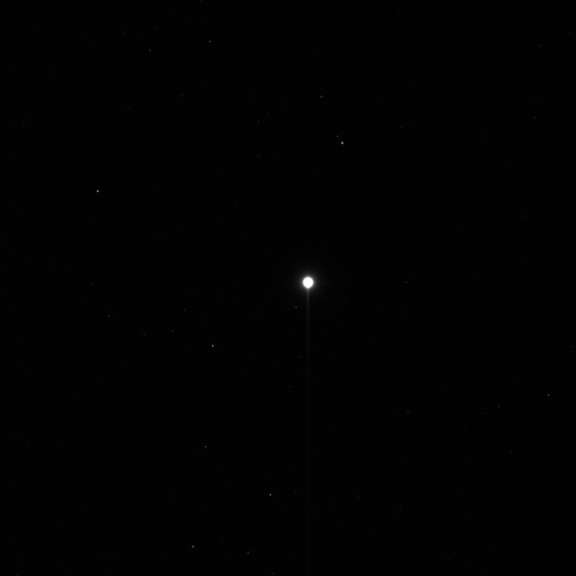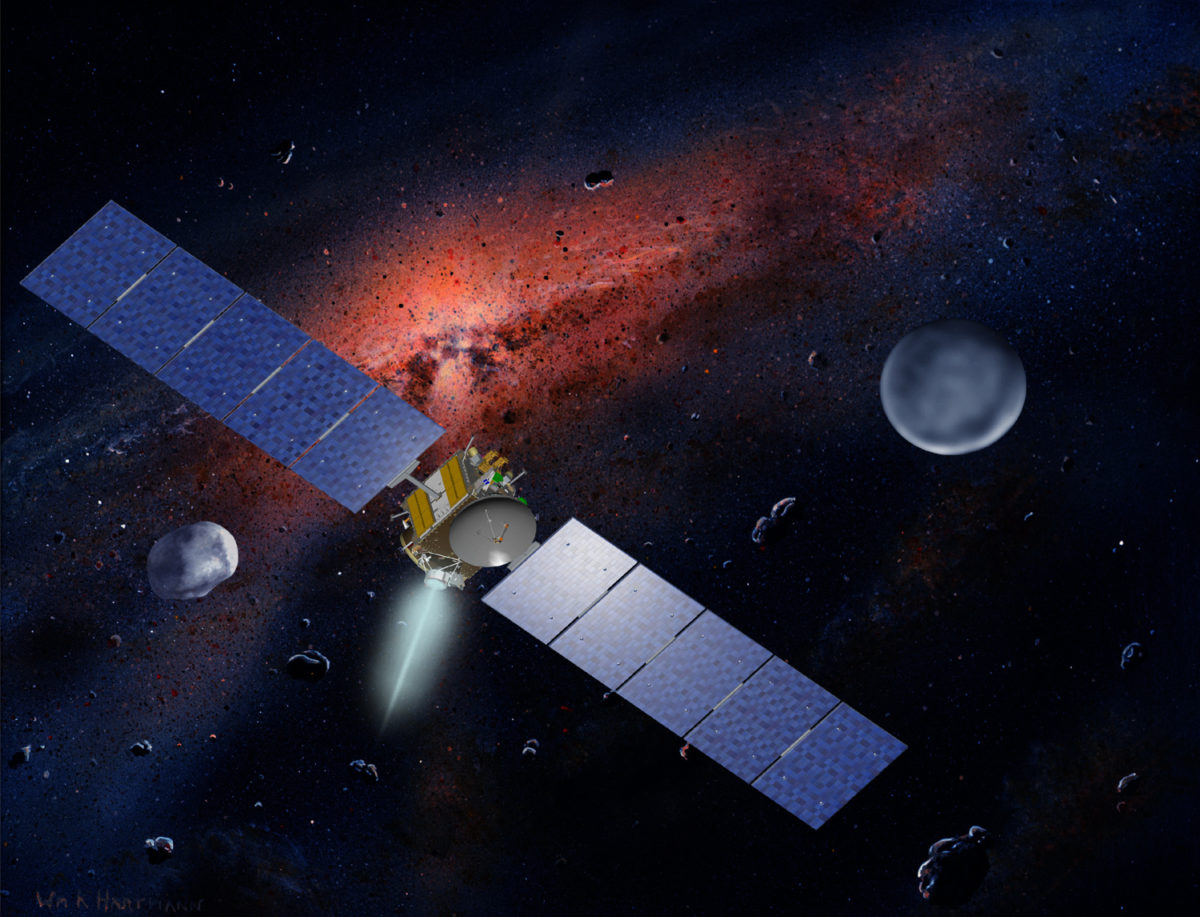Pablo Gutierrez-Marques • Aug 09, 2011
Vesta, a revelation
I love it when space explorers volunteer to write to me about life inside space missions! Especially when they are as passionate as Pablo Gutierrez-Marques. Pablo is Dawn's Framing Camera Operations Manager, and was part of the European contingent of the Dawn mission who came to JPL to support the flurry of activity on Dawn as it entered its science orbit. Pablo participates on unmannedspaceflight.com as pablogm1024, where he has invited others to ask him questions about the camera and mission operations in the Dawn Framing Camera Q&A thread. He is also the person behind the Dawn Framing Camera Facebook page. I hope this is the first of several guest blog posts from Pablo! --ESL
I have to admit it: three months ago I did not understand why space science is important. This is a pretty bold statement coming from a practicing aerospace engineer, but recent events have corrected this lack of understanding, and I am not embarrassed to correct myself in this blog. But let us not get ahead of the story.
It all started, in my early teens, back in my home town in Spain, where my engineering mind was playing tricks on me, luring me into the forbidden realms of toy deconstruction. Luckily, I was also reasonably prudent, and most of the time I was able to restore my experimental subjects back to function with few or no extra parts. At that time I did not have any understanding of science whatsoever.
As my high school years rolled by, my parents, both surgeons, having given up any hope that I would follow in their footsteps, tried to entice me into less potentially dangerous branches of knowledge, like physics or mathematics. But my attention always faltered before I could formulate hypotheses, and I focused instead on dissecting and trying to replicate any kind of computer program that crossed my path. My understanding of science had evolved by then from non-existent to a cloudy concept of a certain type of research that I was not suited to do.
When time confronted me with the decision of which degree to pursue in college, and I had amassed a non-negligible treasure of computing skills, my father advised me to avoid the School of Informatics, where more than one teacher would have been a victim of my hormone contempt. So I veered toward Aerospace Engineering, renowned as one of the most difficult degrees on offer. The sciences were still inaccessible to me, but at least I already understood that some of them were essential pillars in the foundation of my favorite, technology.
Out of college I had the luck (or maybe not) of spending several years in pure engineering jobs, from the qualification of aircraft to the design of fire detection instruments. It was a pleasurable time, where I gained a lot of experience and worked endless hours with a smile on my face doing what I liked best, putting things together, idly ignoring what life had in store for me.
And then, in the late hours of a New Zealand night, this light-spirited escape ended with a phone call. Fate was requesting my support on a scientific space mission led by JPL. First, I felt flattered by the attention I had drawn, then amazed by the aura of NASA and their long-standing history of pioneering, and finally thrilled at the opportunity of living and working in a different country (Germany in this case). By the time I faced the question of how useful my contribution would be, I had already run out of emotions and, left to choose between acceptance and denial, I followed my good nature and joined the project, admitting the evidence that many branches of science had immediate applications to the development and well being of mankind, but without a clear understanding of what benefits could be derived from planetary science.

Months later, recovered from the trance and once again in possession of my mental faculties, I found myself become a skillful mercenary of science, putting all my knowledge to the service of a master who fed me well and whose devices eluded my comprehension. The technical challenge of bringing an instrument first to material life, then out into the endless voids of outer space and finally to a carefully orchestrated choreography of observations was sufficiently enticing to reassure me in my decision. And so I spent seven years, devoting my full attention to the task at hand, building parts, programs, command sequences, questioning only in rare occasions what the final purpose of my work was, until we were in sight of Vesta. Even then, when the target was already in reach and the mission and instrument teams congratulated reciprocally for the achievement, I was unable to share their thrill and felt nothing other than a mundane and quiet complacency over the performance of the camera, pleased of course to see the images coming down at a painfully slow pace, but repeatedly disappointed by a small blur of pixels not so different on my screen from a snowball.
That was the situation a few weeks ago when, suddenly, one day Vesta hit me in the forehead and changed my mind for ever. The images of the ever-approaching asteroid had been coming with weekly regularity without significant improvements in quality and the novelty had already worn off. It had only been seven days since the previous set of observations, so I was ready to receive another pile of nearly featureless smudges, but the hyperbolic laws that rule
erspective caught me off guard. The new photographs not only showed an incredible leap in resolution, but they also revealed such a wealth of features on the surface of Vesta that my resistance was shattered and I immediately turned into a devout follower of that re-born goddess called Vesta. That day and the days that followed with new portraits of the materialized figure of the Roman eras, changing my understanding of the mission, of space science and even science in general.
It is a well-known fact that recent converts are very often the most ardent defenders of the cause they have just embraced. And even if my own migration responds not to faith or religious motives, but only to reason, I will not pretend that I can escape this impulse and will instead yield to it and contribute my grain of sand to the defense of space science.
In the modest language of a non-native English speaker, I contemplate three major arguments in favor of fostering and nurturing scientific space missions like Dawn. The first one is that the science that these missions produce, like many others types of science, contribute to the advancement of knowledge, improving especially our understanding of the Earth as a planet, its role in the solar system and the dynamics around it, and even of the cosmos at large. This knowledge means an immediate profit in the most diverse fields, like the operation of commercial satellites and the disruptions induced by the Sun, the behavior and nature of near-Earth objects and the threat they pose to mankind, and a long list that the reader may complete at his heart's content. But in this sense, admittedly, space science is not different from other types of natural sciences, such as biology, chemistry, geology.
The second reason is of an economic nature. Space science pays the wages of these many professors and post-grads, but also significant industrial expenses go to providers of equipment, materials and specialized services. Furthermore, it is frequent that a space mission finances the development or the advancement of a given enabling technology, and even agrees to fly prototypes of this technology that otherwise would not be developed or proven in flight, just because many commercial space operators cannot afford the risk of relying on experimental devices. And in contrast with the technologies in other fields, like medicine or industrial processing, space technologies are so hard to acquire and so easy to lose that they become of strategic interest: in the same fashion that no country can afford giving up the maintenance of its roads and highways because of the unacceptable cost of re-building a run-down network, no country can afford letting its space science industry dwindle and allowing their talented engineers find a living in the electronics or automotive industry. And this is, indeed, a powerful argument to defend the investment in space science.
But the most potent and incontestable motive, the one that Vesta showed to me a few weeks ago and is unique to space science, is that these missions are one of the few human endeavors where mankind can, still today, leverage and give an expression to the innate impulse of exploration and conquest. We have reached the top of the mountains, the depth of the seas, we have ventured into terrifying caves that pierce the crust of the Earth, we have charted continents and rivers, we regularly conduct experiments in the endless icy expanses of Antarctica, but none of this can transmit, as space exploration does, the amazement of the research, the bewilderment of the encounter, the thrill of spotting territories never before seen by the human eye. And all these sensations are more than a jolt of adrenaline, far more than a chemical cascade in the brain of a few mission team members, because they push forward the common conscience of mankind, nurture the feeling of belonging to one human race and inspire in the generations to come the spirit of adventure and the spark of discovery.

Let’s Go Beyond The Horizon
Every success in space exploration is the result of the community of space enthusiasts, like you, who believe it is important. You can help usher in the next great era of space exploration with your gift today.
Donate Today

 Explore Worlds
Explore Worlds Find Life
Find Life Defend Earth
Defend Earth

